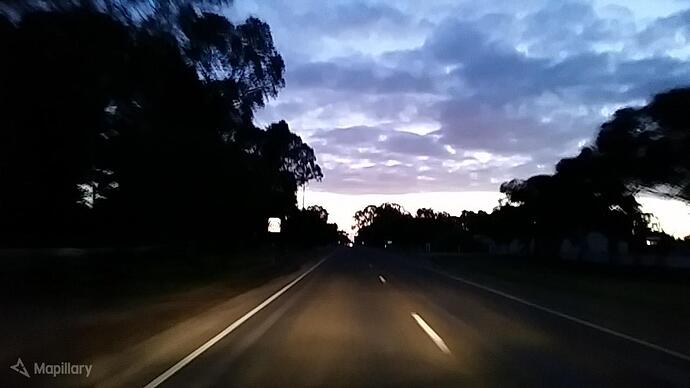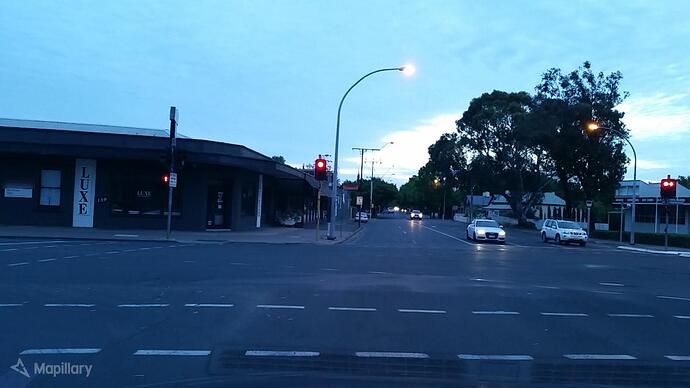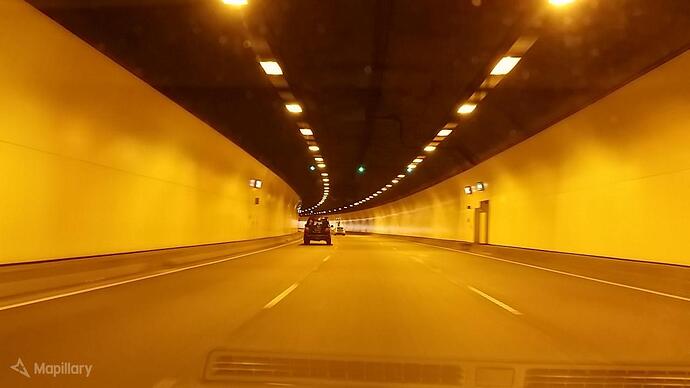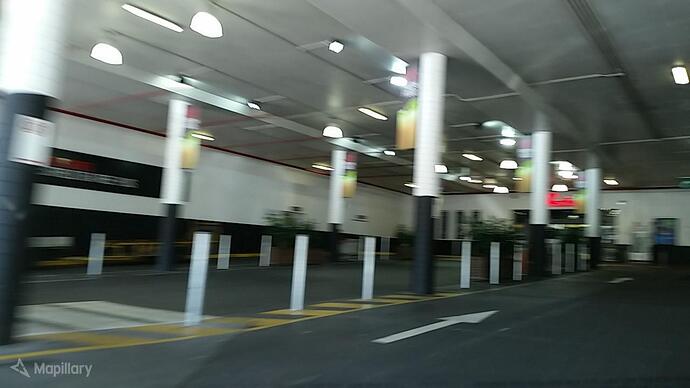Even without sunlight it is possible to show the way =
http://www.mapillary.com/map/im/rwK03T55-o7vZ3BIKBVa0w/photo
Even day-night connections !
I have done early morning and late evening photos with very little issue if there is enough lighting. I get some focusing issues, but minor issues with my Samsung Galaxy S5 running Android 6.0.1 and the latest Mapillary app compared to over a year ago on same phone running Android 5.x and older mapillary.
Here is example photo near Seminole, Alabama, US at 7:26PM local time near sunset and sun behind me while driving East:
https://www.mapillary.com/app/?lat=30.5397089&lng=-87.5629032&z=17&menu=false&pKey=Se_8qvbRrzZxN-4Z3-6otA&focus=photo
If you often take a photo at night, then you will also be interested in reading the advice of shooting at night 15 Nightlife Photography Tips to Capture Low Light Images
Sometimes the night time ones have a nice feel to them
But for Mapillary, I just have a Garmin Virb Elite set up on the passenger side of the windshield ( aka wind screen ) to take a pic every 2 seconds. I doubt the AI stuff will be able to grab much sign information from these. But I would assume it could be used by people at OSM who like to map things, including literally denoting the location of street lights on maps. And some sort of AI could be used to evaluate how well lit the roadway is
I like the example @filipc shared. It’s a great case of how useful it can be for urban environments.
I tried a night sequence yesterday, because I think that people mapping lighting may be interested by that. Although it was downtown in parts of the city that I consider as over lighted and I was driving carefully/slow, the result is quite ugly. I’m not sure that someone can extract valid data from it…
It was with a smartphone. I will try with a digital camera.
The big problem is the motion blur. It is impossible to read text captured while moving.
More so low light levels require the shutter to be open longer causing a blur if any objects move. Also higher ISO settings increase noise.
You could do higher shutter levels but then the image would be darker and may not be as useful.
I don’t think the current versions of Mapillary allow us to control the shutter speed. (An older version did have a slider for adjusting exposure.) They’d have to code in the ability to detect light levels and adjust the camera settings accordingly.
My devices manage that automatically and do a good job of it.
I can keep going until around the time the sun sets/rises. The only blurr during the day would be from tunnels or underground car parks or under lots of trees on a cloudy day when the clouds are quite dark.
Sometimes when coming out of a dark area it doesn’t switch from low light to outdoor and can get images that are flipping between normal and over exposed. This is very rare and usually a reboot of the device solves it.
This is all based on using Mapillary Android version 3.27. I should try the latest version on one of my devices.
I mention they might need to code it in, because I’m not really sure how what they are doing in the app affects the camera. I know that they do push certain settings to the camera based on a few selections in the app (e.g., image size), so I just don’t know what else they might need to do.
My examples:
A sunny day in the evening with trees and hills causing low light levels and some blur. (link)
Sunny day after sunset facing twilight, device was taking longer to take each image. This was the last image I took before shutting off for the night. (link)
Higher speeds where the centre of the image is still clear enough but the edges are blurred. (link)
A stationary image taken in the early morning when light levels were too low for normal image taking while moving. (link)
Acceptable light level in a tunnel while outside was foggy. (link)
Covered car park low light levels while turning causing blurring. Going straight still had acceptable image quality as you can see in the rest of the sequence.
@Didz are you sure that blurring isn’t caused by being on the WRONG side of the road? ![]()
Kidding. That’s just from a camera phone, eh? That’s getting pretty decent with dealing with the low light and the variations. NOt as good as the human eye but it’s progress.
We have the steering wheel on the ‘wrong’ side too so it evens out.
I currently use two Samsung Galaxy S5 across two vehicles.
If you are seeing my images here for the first time it’s probably a bad first impression. I try to take clear images by positioning the camera straight with a good mount I made and always clean the camera and windscreen constantly. I usually avoid taking images in rain unless it’s an area I have not crossed and unlikely to cross again soon.
I just tried a night sequence with my Olympus E-PL6 and kit lens at f=14 mm f/d=3.5. ISO 3200. Underexposed by 1 EV. Resolution set to 4MPixles. Time based capture. GPX recorded with Garmin Etrex 30. Pictures geolocalized with Geosetter.
Still a lot of motion blur ![]()
The photos are blurry because it looks like the focus is off. It doesn’t look like it’s blurry because the focus time is too long. Is there a way to set up a phone camera pixel 3 so that you can take decent night photos and tell it just to focus at Infinity.
There’s no way to change camera settings at all in the mapillary app. If you want that sort of control you need to get a dedicated camera or a Raspberry PI or something but they take a lot more effort to set up.
In general I only upload night images if it’s an area that has no other mapillary imagery at all and there is some decent street lighting
Thanks. This is an area where there is no other mapillary imagery. As the days get longer, there will be more light and I’ll reshoot then and delete the blurry nighttime sequence.





